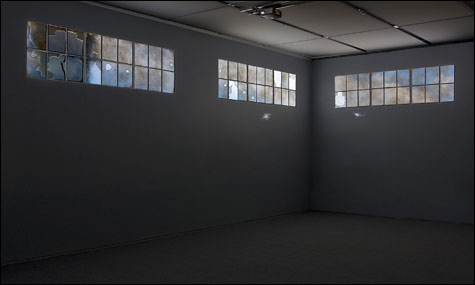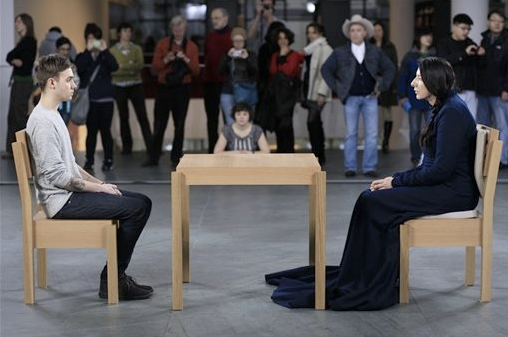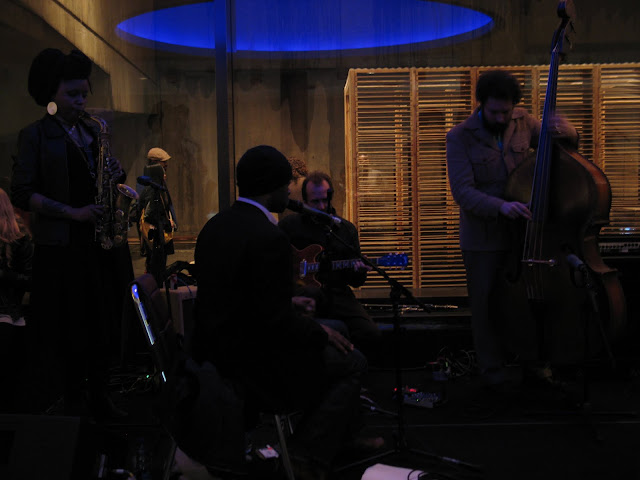In the darkness of a giant room, patrons struggled to discern the silhouette and unmistakable sound of a landing helicopter. Perplexed by the sight, none were ready for the sniper fire that tore through the windows and the car bomb that sent the outside marketplace scattering. It plays with your senses and makes you question if you’re still in Boston or a real war zone in Baghdad. Adrenaline pumped as the mind scrambled to make sense of the chaos unfolding. That frightening moment of confusion was Krzysztof Wodiczko’s desired effect. The Institute of Contemporary Art (ICA) on Boston’s waterfront is hosting Wodiczko’s project “…Out Of Here: A Veterans Project” from November 4, 2009 to March 28, 2010. “…Out Of Here“ is an innovative piece that depicts the horror and uncertainty of trauma as it is experienced by soldiers and civilians alike. Wodiczko has broadened the definition of veterans to include any persons who are submerged in harm’s way in his artist statement.

Krzysztof Wodiczko's "…Out Of Here: A Veterans Project" at the ICA
Krzysztof Wodiczko was born in Warsaw, Poland in 1943. He currently works and resides in New York City and Cambridge, Massachusetts. Since 1980, Wodiczko has created over seventy large-scale video and slide projections of politically inspired images and projected them on famous monuments worldwide. His projections are geared towards human rights, democracy, violence, and estrangement. His work acts as a bridge between art, trauma, healing and justice. The mission of these mobile installations has been to identify and expose issues that society would rather neglect or not discuss. The Gallery looks like the interior of an old warehouse or military base with video projections of seven windows near the ceiling that provides a skyward view. Outside this warehouse, on the outside we imagine to be on the other side of the projected windows, the sounds of an Iraqi marketplace echo through the streets. A group of children are laughing and playing as one kicks a soccer ball up into one of the windows, cracking it. All the talking and laughter is replaced by sudden chaos as an explosion detonates and a sniper fires several rounds through the windows. Black smoke billows skyward panic ensues. Between shouting U.S. soldiers and Humvees barreling into the scene, intense automatic gunfire fights erupt all around. After a few moments of radio chatter, machine gun fire and the eventual departure of the soldiers, the street returns to eerie silence. It is at this moment that a woman discovers her mortally wounded son. Her cries fill the abandoned streets, as her son has become collateral damage. Then the project loops back to the beginning and starts again. What is amazing artistically about this piece is the fact that the art is in what the viewer imagines and feels, not much in what we’re actually seeing. To properly portray the realistic spectrum of horror, Wodiczko interviewed U.S. medics and soldiers as well as Iraqi civilians. From their accounts of hit and run guerilla warfare in a public place, Wodiczko created a reenactment of the battle scene. The consequence of war on soldiers and civilians alike became visible and tangible for the general public. From the safety of our homes, we can read literature and reports of first hand accounts of war and watch the news or see combat depicted in film but written or filmed accounts of battle try to encompass all the details, but this may be the closest most people can come to any experience like it. This is something Wodiczko recognizes. He says, “"I believe that if there is any truth, it lies in realizing the impossibility of gaining full access to the truth of such an experience."
The art lies in our senses and minds, and I think its absolutely genius. Stuck inside a giant room, it isn’t very difficult to image you’re actually there. The sounds alone wouldn’t do it, but he sounds in a giant warehouse, where you feel vulnerable and unsure, completely take over. The viewer creates a mental picture of this battle scene and experiences the fear of ambiguity and vulnerability in guerilla warfare, and receives no closure as to what’s actually happening. After experiencing the intensely disturbing simulated conflict, one can start to comprehend the devastation that war has on anyone involved in such close combat. The ability to trick the mind and the senses into a simulated state of survival and momentary panic is the triumph of Wodiczko’s project.
Molly Geiger is a graduating Senior at the Art Institute of Boston. Her recent work includes an expansive documentary essay on Home Births. For more information please visit her website.







